Special Report
The Government Is Worried About These Biological Weapons

Published:
Last Updated:

Russia accused the United States of secretly supporting a biological weapons program in Ukraine at the U.N. Security Council meeting in March. The U.S. strongly denied the claims. There were concerns this would be used as a pretext for Russia’s own use of chemical or biological warfare in Ukraine. Since then, the Kremlin has continued to spread such claims — but provided no proof — culminating last month in Russia requesting a formal hearing of violations of the U.N. Biological Weapons Convention
The convention, which went into effect in 1975, prohibits the development, production, stockpiling or otherwise acquisition of biological weapons. Nearly universally adopted, 184 countries signed the agreement – and for good reason.
Biological weapons are designed and used to spread pathogens or toxins that can harm or kill humans, animals or plants. The consequences of their use can be severe and unpredictable, potentially resulting not only in illness and loss of life across populations, but also food shortages, environmental catastrophe, economic harm, and widespread fear.
Not confined to national borders, these effects could spread beyond their intended target and lead to global devastation.
Still, the international ban on biological weapons offers no guarantee of compliance. A report issued by the U.S. State Department as recently as 2019 raised concerns that China, Iran, North Korea, and Russia – all parties to the BWC – are potentially flouting some of the terms of the convention. Some of these countries are recognized to be some of the most corrupt in the world.
Non-state actors, including terrorist groups, could also potentially employ the use of biological weapons. In 2001, letters laced with anthrax were sent through the U.S. mail, infecting nearly two dozen people and killing five. The suspected perpetrator of what is remembered as the worst biological attack in U.S. history was a biodefense researcher with the U.S. government who took his own life before he was brought up on charges.
Government organizations, including the Department of Defense and the Centers for Disease Control and Prevention still consider biological weapons a potential threat to the United States. Using data from government reports and medical journals, 24/7 Wall St. identified the 25 biological weapons the U.S. government is worried about.
The weapons on this list are ordered in terms of their priority classification by the CDC – from third highest to highest. The highest priority bioweapons are those that are easiest to transmit and have the highest potential for public harm and social disruption. (Also see, the world’s most dangerous chemical weapons.)
Click here to see which biological weapons the government is worried about.
Click here to see our detailed methodology.

25. Hantavirus
> CDC priority: Third highest priority
> Lethality if untreated: 38%
Hantaviruses are a group of viruses that can lead to respiratory and cardiovascular failure. Symptoms of the virus often include fatigue, fever, shortness of breath, coughing, and muscle aches – and, after 4-10 days, the lungs can fill with fluid.
Though the Hantavirus is typically spread by rodents – specifically certain species of mice and rats in the United States – the CDC has acknowledged the potential weaponization of the hantavirus for use against American citizens. An estimated 3,000 American and Korean troops were infected with Hantavirus during the Korean War, but there is no evidence suggesting the infections were the result of a deliberate attack.
[in-text-ad]
24. Nipah virus
> CDC priority: Third highest priority
> Lethality if untreated: 40%-70%
The Nipah virus is spreadable between animals, such as fruit bats or pigs, and humans. Symptoms can appear anywhere between four days to two weeks after infection. Early signs include dever, headache, coughing, sore throat, and difficulty breathing. Later stage symptoms can include brain swelling, which can progress to coma in as little as two days.
Treatment for the virus is limited to supportive care involving rest, hydration, and symptom relief. The virus often results in death, and though the only known outbreaks of the virus have been in Asia – first in Malaysia and Singapore and later in Bangladesh and India – the CDC has identified Nipah as a potential agent for biological weapons.
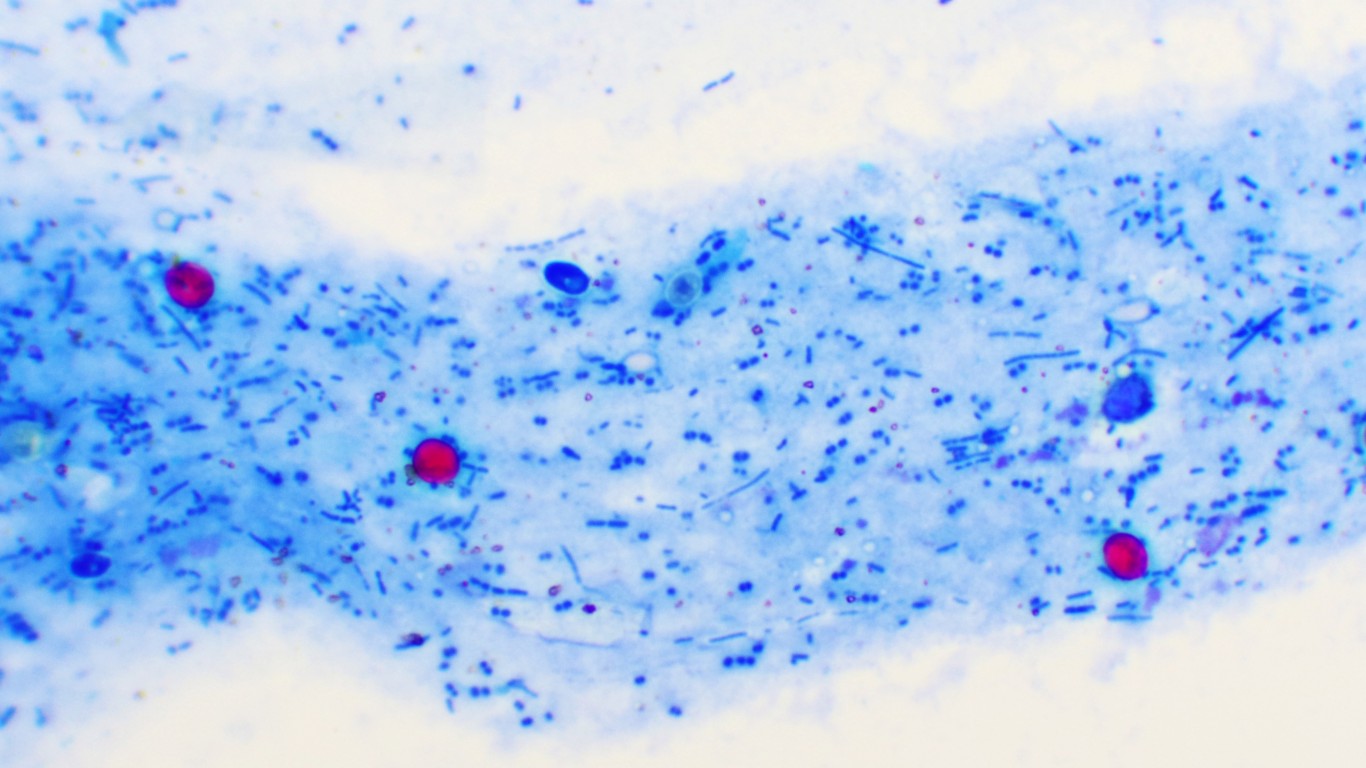
23. Cryptosporidium parvum
> CDC priority: Second highest priority
> Lethality if untreated: Low
Cryptosporidium – known simply as Crypto – is a microscopic parasite that can cause a disease in humans, also called Crypto. The parasite has been identified by the CDC as a potential weapon of biological terrorism. Protected by an outer shell, the parasite is resistant to chlorine-treated water and is the most common waterborne disease in the United States. Infections can occur after swallowing infected water or eating uncooked, contaminated food.
Symptoms of Crypto can come and go over the course of a month and typically include diarrhea, stomach cramps, vomiting, and dehydration. For people with weakened immune systems, the disease can be fatal.
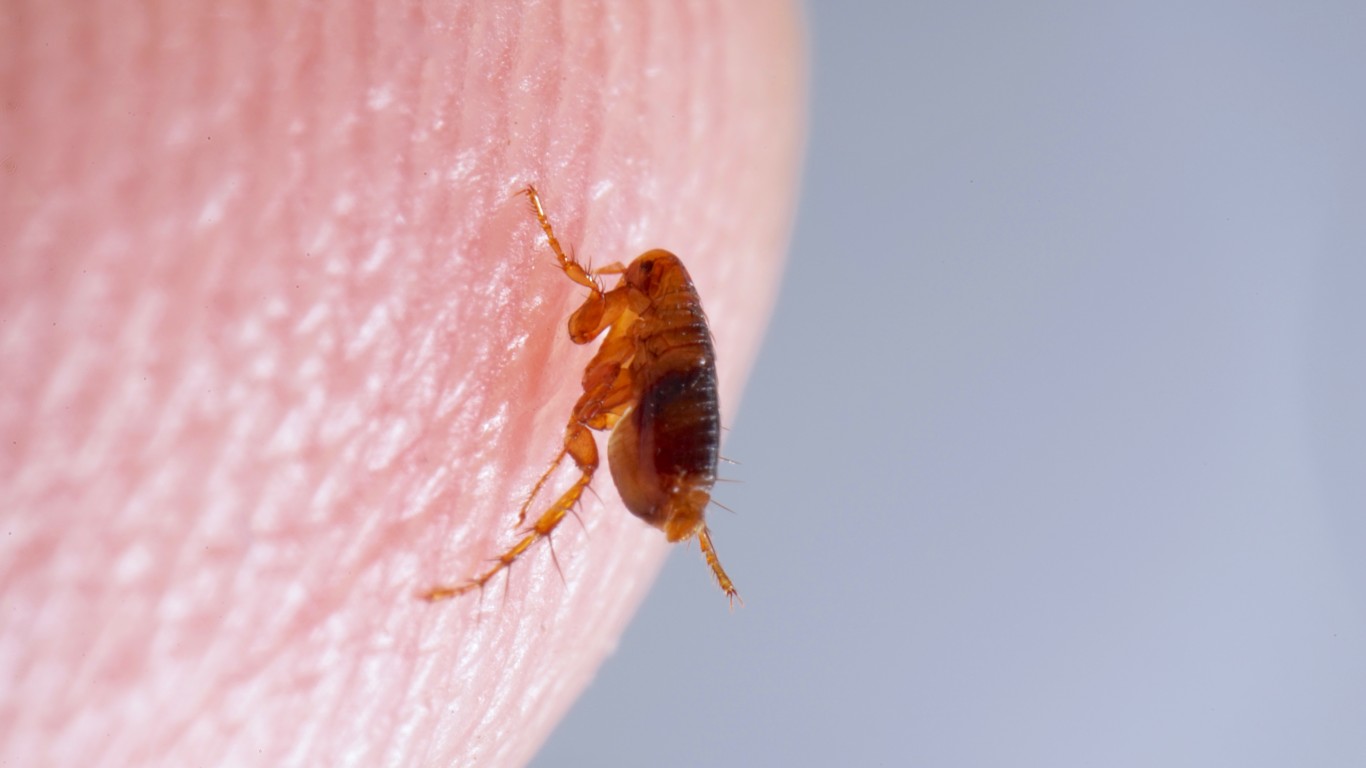
22. Typhus fever (Rickettsia prowazekii)
> CDC priority: Second highest priority
> Lethality if untreated: Low
Typhus fevers are a family of diseases that can be spread to humans through bacteria from fleas, lice, and chiggers. Symptoms typically occur between 10 days and two weeks after infection and can include fever, chills, rapid breathing, body and muscle aches, rash, and vomiting. Some forms of typhus can be treated with antibiotics while others often do not require treatment. Still, severe forms of the disease can develop and result in organ damage, orgran failure, and death.
There are no known cases of typhus being deployed as a biological weapon. However, Japan considered it a candidate for airborne dissemination in World War II as was the Soviet Union in the 1970s.
[in-text-ad-2]
21. T-2 Mycotoxins
> CDC priority: N/A
> Lethality if untreated: Moderate
T-2 Mycotoxins are a type of mold that are toxic to humans, especially when inhaled. The toxins can occur naturally or be produced in a lab and can result in skin pain, severe itching, skin shedding, bloody coughing, wheezing, and chest pain. Severe intoxication results in weakness, collapse, shock, and death.
The Soviet Army was suspected of using T-2 in Southeast Asia from 1975 to 1984, releasing aerosol droplets of the toxin from aircraft on hundreds of occasions, killing an estimated 6,500 people in Laos alone.

20. Staphylococcal enterotoxin B
> CDC priority: Second highest priority
> Lethality if untreated: <1%
Staphylococcal enterotoxin B, or Staph, is a biological toxin that can cause gastrointestinal illness in people who have eaten food contaminated with the toxin. An estimated 25% of people have Staph on their skin and can contaminate food with the bacteria if they do not wash their hands before preparing foods that will not be cooked before they are eaten.
Food poisoning caused by Staph typically includes nausea, vomiting, stomach cramps, and diarrhea and manifest between 30 minutes to 8 hours after ingestion. Notably, the disease cannot be passed directly between people, and severe illness is rare. The CDC has identified Staph as a potential agent for biological weapons.
[in-text-ad]

19. Psittacosis (Chlamydia psittaci)
> CDC priority: Second highest priority
> Lethality if untreated: 15-20%
Psittacosis is a type of bacteria that can infect birds and people who come into contact with infected birds. Higher-risk individuals include bird owners, pet shop employees, poultry workers, and veterinarians. Symptoms are usually mild and include fever, chills, headache, muscle aches, and dry cough. Symptoms begin to manifest within five days to two weeks after infection. The disease is treatable with antibiotics, though more serious complications such as hepatitis, pneumonia, endocarditis, or brain inflammation can occur.
Both the United States and the Soviet Union studied the bacteria as a possible biological weapon for incapacitating adversaries. A weaponized version of the bacteria would likely be delivered by aerosolization. Untreated, psittacosis is lethal in as many as 20% of cases, but with treatment, its mortality rate is less than 1%.
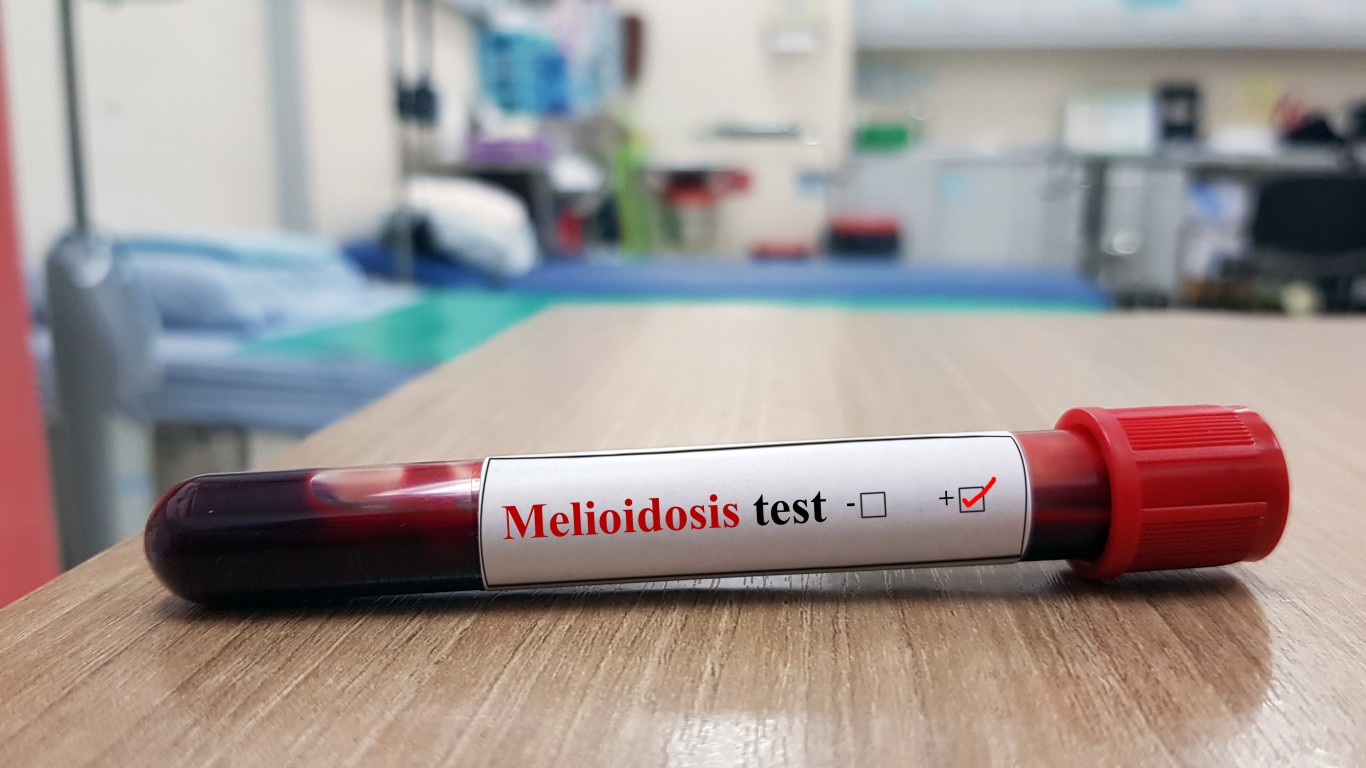
18. Melioidosis (Burkholderia pseudomallei)
> CDC priority: Second highest priority
> Lethality if untreated: up to 90%, according to CDC, over 70% according to Nature, 19â 50% for severe disease
Melioidosis, also known as Whitmore’s disease, is a bacterial disease predominantly found in tropical climates that can spread to humans or animals. Humans can be infected simply by inhaling dust particles or water droplets from contaminated soil or water. Symptoms can vary depending on the type of infection and range in severity from fever and headache to seizures and brain infection. The disease is treatable with two eight-weeks of intravenous antimicrobial therapy followed by three to six months of oral antimicrobial therapy.
A biological attack involving melioidosis could involve releasing germs in a crowded place or targeting livestock. Even though melioidosis has not been weaponized so far, it kills an estimated 90,000 people worldwide annually.

17. Shigella
> CDC priority: Second highest priority
> Lethality if untreated: Low
Shigella is a type of bacteria that can infect humans with shigellosis through ingesting contaminated food or water. Symptoms include diarrhea, fever, and stomach cramps. Severe shigellosis can spread into the blood and can be life threatening. Symptoms start to show within a day or two of infection and can last up to a week, though antibiotics can reduce the duration of illness. The CDC has identified Shigella as a potential agent for biological weapons.
[in-text-ad-2]
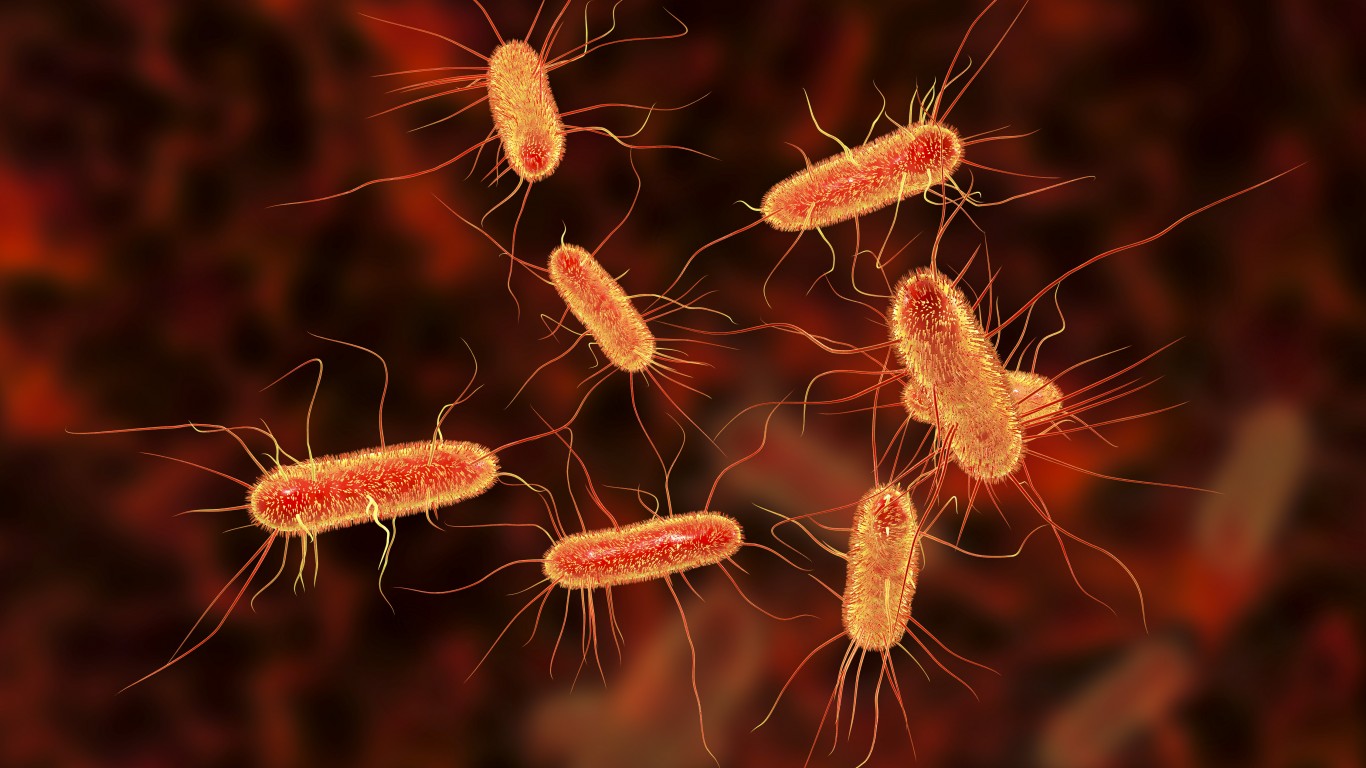
16. Escherichia coli O157:H7
> CDC priority: Second highest priority
> Lethality if untreated: Low
Escherichia coli O157:H7, or E. coli, are a large group of bacteria that can be found in the environment, certain foods, and animal and human intestines. The symptoms of people infected with E. coli can vary widely but include severe stomach cramps, diarrhea, and vomiting. Between 5% to 10% of infected humans develop a potentially life-threatening complication known as hemolytic uremic syndrome, which can cause kidney failure. Illness is commonly treated with rest and rehydration.
15. Ricin (Ricinus communis)
> CDC priority: Second highest priority
> Lethality if untreated: High
Ricin is a lethal poison that occurs naturally in castor beans. Though it has been used experimentally to kill cancer cells and is a byproduct of castor oil manufacturing, it is perhaps best known as a biological weapon. Bulgarian journalist Georgi Markov was killed by ricin poisoning in London in 1978 after being injected with the poison by the tip of an umbrella. The U.S. experiemented with ricin as a warfare agent in the 1940s, and some terrorist groups are suspected of using ricin in recent decades.
Ricin works by stopping cells from producing necessary proteins, causing them to die. The effects of the poison change depending on dosage and whether it is ingested, inhaled, or makes contact with the skin. Death from ricin can occur within 72 hours of exposure. There is no known antidote for ricin poisoning.
[in-text-ad]
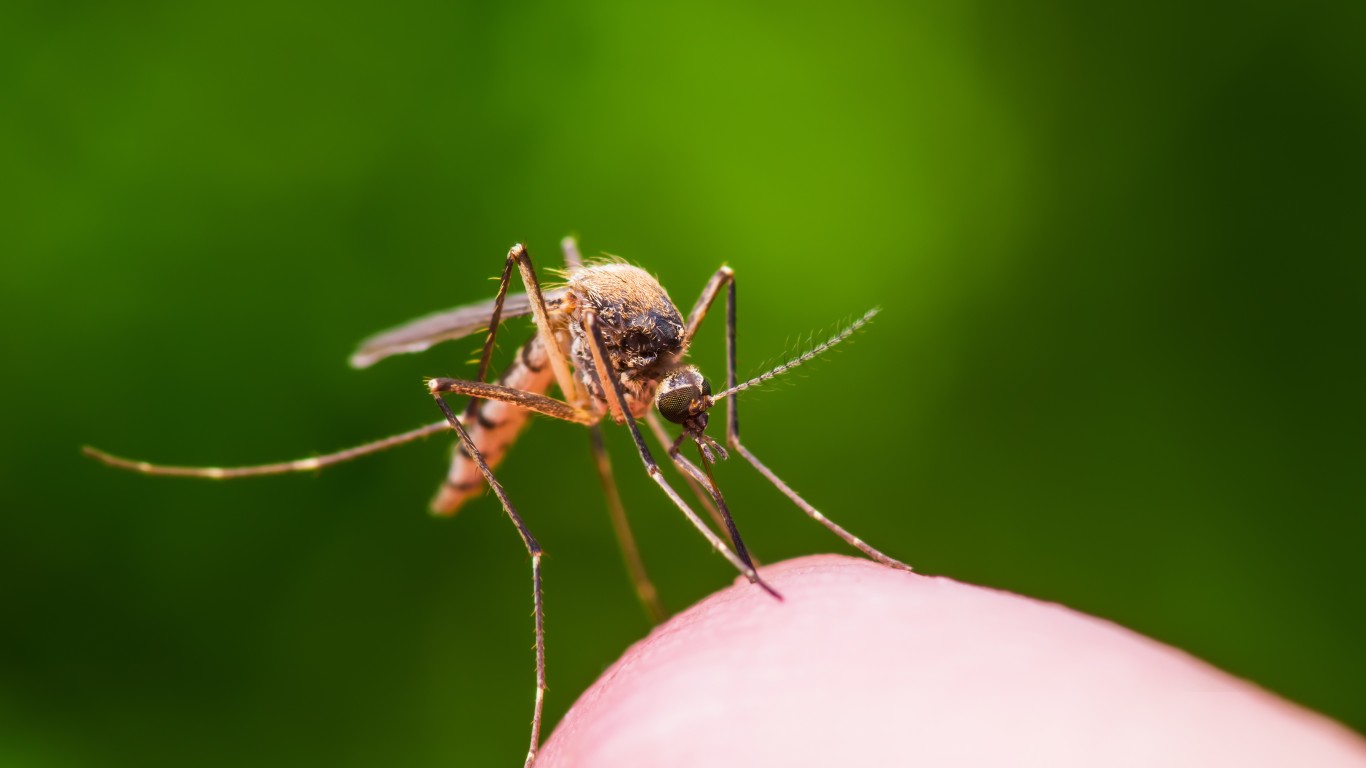
14. Encephalitis (Alphaviruses): Venezuelan (VEE), Eastern (EEE), Western (WEE)
> CDC priority: Second highest priority
> Lethality if untreated: VEE: <10%, EEE: 50-75%, WEE: 10%
The eastern equine encephalitis virus, or EEE, is typically passed to humans through bites from infected mosquitos. Though rare, the disease is serious, often resulting in death or ongoing neurologic problems. While no specific antiviral treatment exists for the diseases, infected people often require hospitalization for treatment. In most cases, symptoms include fever, chills, body aches, and joint pain and resolve in two weeks or less. More severe symptoms, including seizures, behavioral changes, and coma can occur and result in death even years later.
Before terminating its biological weapons program, the U.S. developed a weaponized version of the Venezuelan equine encephalitis virus, or VEE. A Soviet scientist also dropped a vial of VEE in a lab stairwell in 1959 and 20 staff were infected.
13. Q fever (Coxiella burnetii)
> CDC priority: Second highest priority
> Lethality if untreated: Very low
Q fever is a disease caused by a bacteria found in some animals such as goats, sheep, and cattle, known as Coxiella burnetii. Infection in humans is typically caused by breathing in dust contaminated with the infected animal feces, urine, or milk. Common symptoms are flu-like and include fever, chills, fatigue, and muscle pain. While most people will recover naturally, rarer cases require a two week course of antibiotics.
Q fever is easily weaponized, as it can survive up to 60 days on some surfaces and is infectious in very small doses. Before the U.S. signed the U.N. Biological Weapons Convention of 1972, it had developed over 5,000 gallons of Q fever as a biological weapon.

12. Glanders (Burkholderia mallei)
> CDC priority: Second highest priority
> Lethality if untreated: 90%
Glanders is an infectious disease that mostly affects horses but can also pass to donkeys, mules, goats, dogs, and cats – as well as humans. The disease is transmitted to humans when the Burkholderia mallei bacteria enters through the eyes, nose, or skin abrasions from the bodily fluids of infected animals. The disease is rare in humans but very serious, with a 90% mortality rate if untreated and a 50% mortality rate with antibiotics. It can cause pneumonia and ulcers in the nose, mouth, throat, and lungs.
A biological attack using glanders could involve the release of germs in the air or water and food supplies. In World War I, Germany reportedly spread glanders to disable allied cavalry units. Additionally, according to some sources, the Soviet Union developed over 2,000 tons of an agent for glanders in a single year in the 1980s.
[in-text-ad-2]
11. Cholera (Vibrio cholerae)
> CDC priority: Second highest priority
> Lethality if untreated: Low with treatment, high without
Cholera is an acute illness caused when the intestine is infected with the Vibrio cholerae virus, usually by ingesting contaminated food or water. Symptoms include diarrhea, vomiting, cramps, and dehydration. While infections are often mild, they can also be severe and result in kidney failure or death.
Though cholera is rare in industrialized nations like the United States, an estimated 1.3 million to 4 million people globally get cholera each year, and 21,000 to 143,000 people die from it. The CDC has identified it as a potential agent for biological weapons.

10. Epsilon toxin of Clostridium perfringens
> CDC priority: Second highest priority
> Lethality if untreated: Rare
The epsilon toxin, or ETX, is a poison that causes enterotoxemia, a deadly disease in some domesticated animals, like sheep. Due to its potency, ETX is considered a potential biological weapon. ETX is one of the toxins of type B and type D strains of C. perfringens, a relatively common bacteria that is behind an estimated 1 million cases of food poisoning in the U.S. each year.
[in-text-ad]

9. Brucellosis (Brucella species)
> CDC priority: Second highest priority
> Lethality if untreated: Deaths in 2% of cases
Humans can become infected with brucellosis after coming into contact with or by ingesting raw milk or undercooked meat of an infected animal – typically sheep, cattle, goats, pigs, or dogs. Symptoms include fever, sweats, malaise, anorexia, headache, and muscle or joint pain. The disease is treatable with antibiotics, though recovery may take months.
Due to its potential for airborne transmission, it has been heavily researched as a potential biological weapon. In the 1950s, before America’s biological weapons program was dismantled, the U.S. military developed bombs that contained the pathogens that cause brucellosis. The pathogen was favored by the U.S. due to its ability to debilitate with a low mortality rate.

8. Tularemia (Francisella tularensis)
> CDC priority: Highest priority
> Lethality if untreated: Moderate
Tularmeria is a disease that is particularly deadly for animals like rabbits, hares, and rodents. Humans can also be infected through tick and deer fly bites, or contact with infected animals, or by ingesting contaminated water or inhaling contaminated aerosols. Symptoms can be mild and typically include a fever and range from skin ulcers and pneumonia to a sore throat and headache – though the disease can also be fatal.
The disease is difficult to diagnose but is treatable with antibiotics. There have been fewer than 400 cases reported annually in the U.S. since the 1960s. Because of the disease’s potential for use as a biological weapon, the Department of Defense in 2020 awarded researchers at the University of Texas at San Antonio and Lovelace Respiratory Research Institute with an $18 million contract to develop a vaccine.
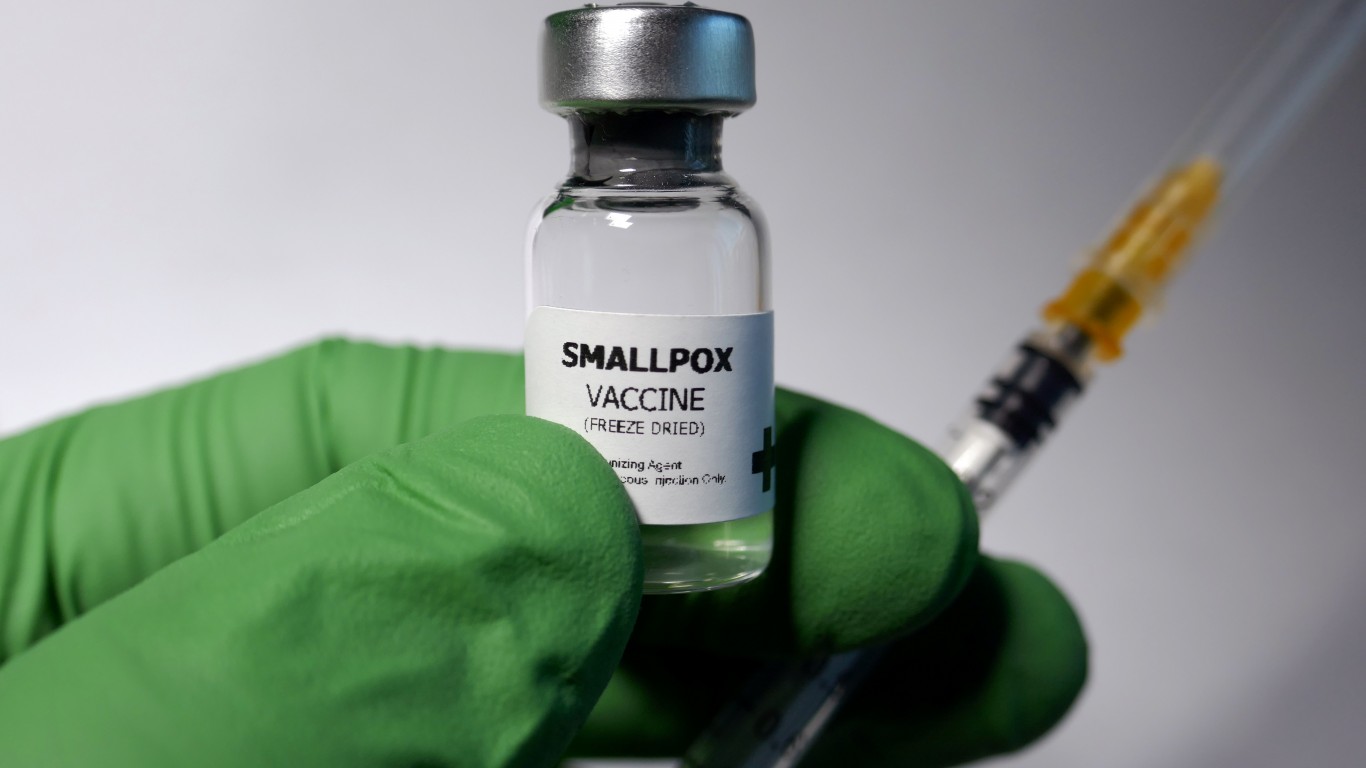
7. Smallpox (Variola major virus)
> CDC priority: Highest priority
> Lethality if untreated: High to moderate ≥ lethal
For thousands of years, the smallpox virus posed a deadly risk to humans. Early symptoms include fever and headache, followed by rashes and scab formations. However, since a vaccine was developed and widely adopted, the World Health Assembly declared the diseases eradicated in 1980.
Though no naturally occurring smallpox cases have been reported since 1977, smallpox remains a biological weapon threat. Smallpox was used as a weapon in the French and Indian Wars and was cultivated by the Soviet Union in the 20th century and could potentially be used again as Americans are no longer routinely vaccinated — and for those who are, vaccines do not offer lifelong immunity.
[in-text-ad-2]
6. Plague (Yersinia pestis)
> CDC priority: Highest priority
> Lethality if untreated: High unless treated within 12â24 hours (pneumonic)
The plague killed millions of people across Europe in the Middle Ages. Though it is still contractible today through bites from infected rodent fleas, it is treatable with antibiotics – if caught early.
The CDC acknowledges that the plague could be used as a biological weapon in a number of scenarios, including an aerosol attack releasing tiny droplets in the air in a crowded place. Early symptoms include fever, headache, weakness, and chills. During World War II, Japan experimented with weaponizing the plague, and in the First World War, Germany reportedly attempted to spread the plague in St. Petersburg to weaken Russia.
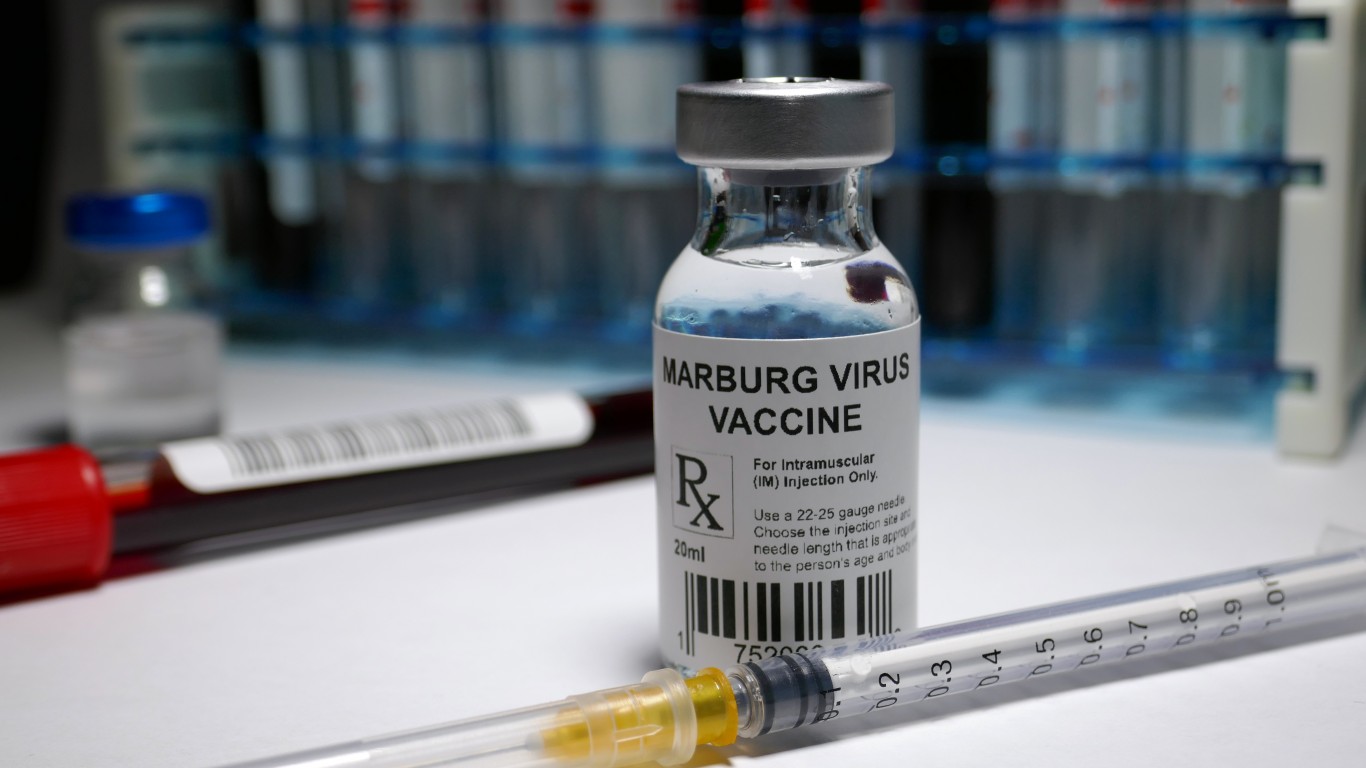
5. Marburg (Viral hemorrhagic fever)
> CDC priority: Highest priority
> Lethality if untreated: >25% lethal
The Marburg disease was first recognized in 1967, when outbreaks of the viral hemorrhagic fever occurred in research laboratories in Germany and the former Yugoslavia, resulting in the deaths of seven of the 31 infected people. The rare disease can infect both humans and monkeys if bitten by infected fruit bats. Symptoms include a sudden onset of fever and headache, followed by vomiting and diarrhea, rash, and generalized bleeding in severe cases.
There is no specific treatment for the disease. The Soviet Union is confirmed to have developed a biological weapon using the Marburg virus in the 1980s in its biological weapons program, biopreparat.
[in-text-ad]

4. Lassa (VHF arenvirus)
> CDC priority: Highest priority
> Lethality if untreated: ~2%
Lassa fever is a viral illness endemic to parts of West Africa that infects between 100,000 and 300,000 people annually and results in about 5,000 deaths. Spread by the common African rat, the disease is transmitted to humans through ingestion or inhalation of urine or droppings of infected rats, often through contaminated food. Most infected people have mild symptoms, including general malaise, weakness, and headache. Serious symptoms show in about 20% of those infected and include shock, tremors, encephalitis, and organ failure.
Certain antiviral drugs can offer effective treatment if administered early. Lassa was one of the biological weapons in development by the Soviet Union, and it remains a potential threat to the United States, according to the CDC.
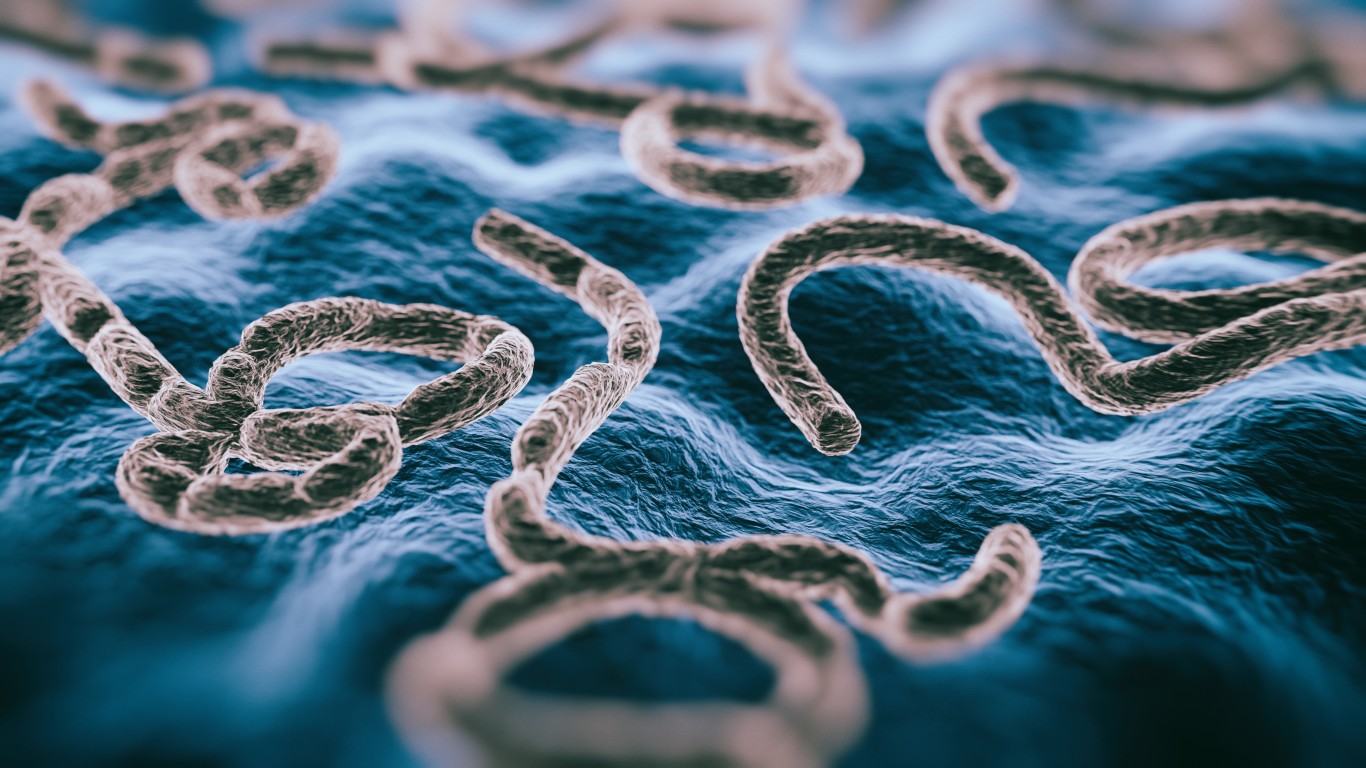
3. Ebola (Viral hemorrhagic fever)
> CDC priority: Highest priority
> Lethality if untreated: 50-80% lethal
Ebola is a rare and deadly disease that can spread to humans through contact with animals such as fruit bats and primates infected with the virus. As recently as 2018, the virus infected thousands of people in the Democratic Republic of the Congo, about two-thirds of whom died as a result. Early stages of the virus can manifest as a fever and headache, followed by vomiting and diarrhea, rash, and in severe cases, generalized bleeding.
Ebola was one of the biological weapons in development by the Soviet Union and was also considered by the Japanese cult Aum Shinrikyo, the group that released sarin gas in a Tokyo subway in 1995.

2. Botulism (Clostridium botulinum toxin)
> CDC priority: Highest priority
> Lethality if untreated: High without respiratory support
Botulism is a rare but serious disease caused by a toxin that exists naturally in certain environments often that are low in oxygen, acid, sugar and or salt. It can be found in improperly home-canned, preserved, or fermented food. In infected humans, symptoms usually start with muscle weakness and can develop into difficulty breathing, paralysis, and death. Infection can be treated with antitoxin drugs and requires weeks or months of hospitalization.
The toxins that cause botulism cannot be seen, tasted, or smelled and could potentially be used as a biological weapon if deliberately spread in the air or food supply. The U.S. produced the toxin during World War II and had over a million doses of antitoxin available for Allied troops pushing into the European continent. Iraq is also said to have produced enough of the toxin to kill every human being on Earth after the 1991 Gulf War.
[in-text-ad-2]

1. Anthrax (Bacillus anthracis) (inhalational)
> CDC priority: Highest priority
> Lethality if untreated: High, depending on delivery method can be >85%
Anthrax is a deadly disease that can be passed from infected animals and animal products to humans. It can also be weaponized for bioterrorism. Contagion can occur through inhalation, ingestion, and skin contact. Symptoms of the disease can take anywhere from one day to over two months to show, depending on the type of delivery and can manifest as skin blisters or sores, fever, chills, body aches, bloody vomiting, and shortness of breath. Anthrax is treatable with antibiotics and antitoxin and hospitalization, if caught early.
Anthrax spores are highly resilient and can be produced in a laboratory. In 2001, anthrax powders were deliberately sent through the U.S. mail, infecting 22 people and resulting in five deaths.
Methodology
To find the biological agents that could become weaponized, 24/7 Wall St. reviewed several sources, including the Centers for Disease Control and Prevention’s Bioterrorism Agents/Diseases, the U.S. Army Medical Research Institute of Infectious Diseases Medical Management Of Biological Casualties Handbook seventh edition from September 2011, a 2004 fact sheet on News & Terrorism, Communicating In A Crisis from the National Academies and the U.S. Department of Homeland Security, and Arizona Department of Health Services’ Zebra Manual: A Reference Handbook For Bioterrorism Agents. All data is from these sources. Agents are ordered by CDC priority, from third highest to highest.
Start by taking a quick retirement quiz from SmartAsset that will match you with up to 3 financial advisors that serve your area and beyond in 5 minutes, or less.
Each advisor has been vetted by SmartAsset and is held to a fiduciary standard to act in your best interests.
Here’s how it works:
1. Answer SmartAsset advisor match quiz
2. Review your pre-screened matches at your leisure. Check out the advisors’ profiles.
3. Speak with advisors at no cost to you. Have an introductory call on the phone or introduction in person and choose whom to work with in the future
Thank you for reading! Have some feedback for us?
Contact the 24/7 Wall St. editorial team.